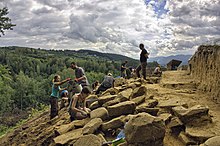Góra Zyndrama
Góra Zyndrama ( German "Zyndram Hill" , see Jan Zyndram von Maszkowice ) in Maszkowice near Łącko in southern Poland has been known as an archaeological site since the beginning of the 20th century. The first excavations took place between 1959 and 1975, whereby a well-preserved settlement was discovered, which over the period from about 1000 to 50 BC. Was inhabited. From 2010 previously unexplored areas were excavated. The field work showed that an earlier settlement dated to the Early Bronze Age existed under the settlement .
This settlement was not inhabited by the ancestral local population who had settled in Lesser Poland since the Neolithic Age, but by a relatively small group of 150–200 "colonists" from the Tisza basin in Hungary . Several sites of the so-called Otomani or Füzesabony culture, including the fortified settlement of Trzcinica near Jasło (known as Troy of the North or as Karpatentroja - Polish Karpacka Troja ) were from the Polish Carpathian region and neighboring regions in Slovakia and Well known in Hungary (cemeteries of Gelej, Hernádkak, Pusztaszikszó, Streda nad Bodrogom, Megyaszó, Füzesabony, Tiszapalkonya, Tiszafüred and Nižná Myšl'a). Analyzes of the ritual of the dead and the social structure reveal a break in the development of this culture around the end of the Hungarian Middle Bronze Age. The most obvious sign of this is the increased incidence of cremation.
The new settlers leveled the hill by creating a plateau of about 5000 m² (about 70 × 70 m). Most of the earth at this level was used to build a terrace on the gentle eastern and northern slopes, which increased the level area of the settlement. This construction was reinforced by a dry stone wall made of large sandstone blocks with clay plaster. Geomagnetic analyzes showed that the 120–140 meter long wall surrounded the settlement in the east and north. It acted as a retaining wall and defensive structure up to 3.0 m high.
This aspect of the settlement makes it particularly interesting for the researchers, as there are fewer than 20 locations in Central Europe from such an early date that have intact stone fortifications. During the Early Bronze Age, the use of stone as a building material was typical of the Mediterranean world, while ramparts in the temperate zones of Europe were built of wood and earth until the early Middle Ages.
The 2015 excavation campaign focused on examining the terrace, where something completely unexpected was found. After removing the residues of the retaining wall on the slope side, the outer surface of a massive wall made of close-lying sandstone blocks of 70 cm to 100 cm in length was found. Instead of the irregular blocks that formed the inner surface, the outer surface of the wall contained many wall associations formed from coarse hexagons, still firmly connected and preserved in situ , with a height of up to 1.0 m. Taking into account the height of the terrace and the number of sandstone blocks that had fallen from the wall, it is logical to assume that the original wall reached about 3.0 m in height. In addition, the remains of a gate, consisting of a 1.3 m wide passage, were discovered. The monumentality of the between 1750 and 1690 BC Stone architecture dated to the 4th century makes the fortification the oldest example of a stone wall in Poland.
Bronze Age fortifications appeared at the transition from the Old Bronze Age to the Barrow Bronze Age around the middle of the 16th century BC. In Central Europe. In the following centuries they condensed into castle horizons at certain times, each time having its own characteristics. The early fortifications are relatively small with a maximum of 3 hectares. In the east and south-west of Slovakia, their multifaceted functions as domination and cult centers, but also as settlements specializing in particular branches of handicrafts such as pottery or bone processing, could be demonstrated at that time. In many cases, there are indications of fixed metal processing; this is where the first real bronzes were produced. In addition, the goldsmith's craft left artistic work. The cultural radiation emanating from the Otomani culture in western Romania (near Großwardein , Romanian Oradea), Mad'arovce in south-western Slovakia and Věteřov in Moravia also carried the fortifications to Bohemia , southern and central Germany and Switzerland . Examples are the Runde Berg near Bad Urach , the Heuneburg near Hundersingen and the hillside settlement "Waldi" in Toos in the canton of Thurgau .
Web links
- [1] Chronology and ritual of the dead of the Otomani-Füzesabony culture
Coordinates: 49 ° 33 ′ 17 ″ N , 20 ° 27 ′ 55 ″ E

